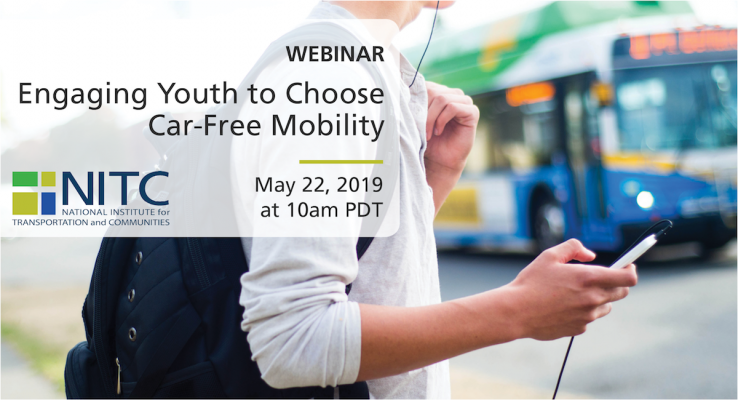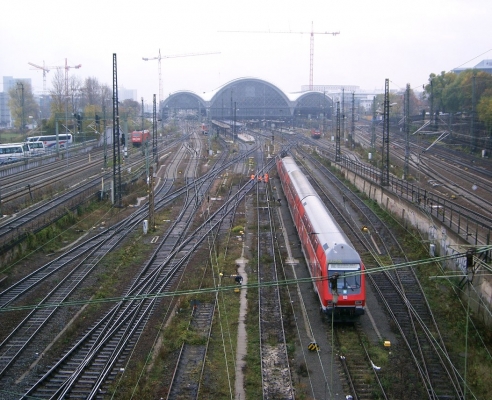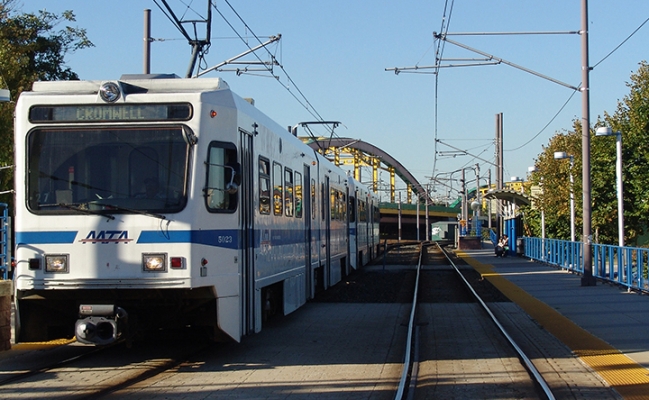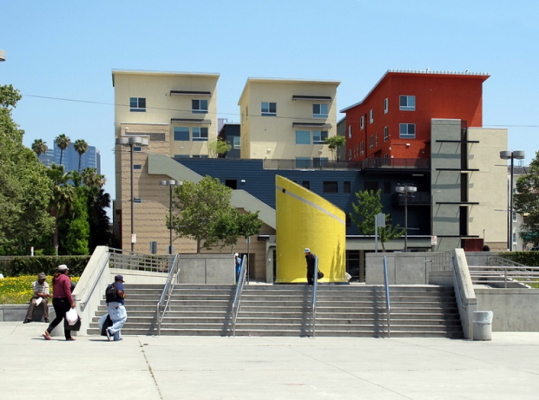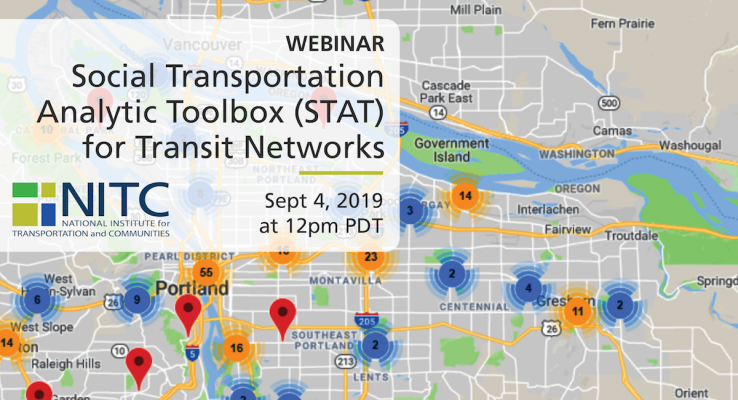The video begins at 0:36.
PRESENTATION ARCHIVE
Miss the webinar or want a look back?
OVERVIEW
Today’s youth are tomorrow’s riders, bikers, walkers, voters, and transportation planners. As more transit agencies begin to offer free fare passes to public middle and high school students, it is important to have good communication strategy in place to encourage transit usage so they don't miss out on the potential to affect behavior change.
Thus, transit agencies need to develop age-appropriate messaging strategies and tactics that promote youth car-free mobility.
This webinar will present results from a NITC research project that sought to create and evaluate communication messaging that fosters more positive attitudes, intentions, and behaviors related to transit and other car-free transportation options among Portland youth. While there is no "one size fits all" approach, the Portland-based findings may yield insights that could be adapted for application in other regions.
KEY LEARNING OUTCOMES...
Read moreThe video begins at 3:55.
View slides
Abstract: Portland is planning to launch a bike share system. Bike share is a new form of public transit that is rapidly spreading through the United States. In 2009, bike share operated in two U.S. cities. Today, 20 US cities operate systems with another 15 in the planning stages. In several cities, including Denver, Minneapolis and Washington, DC bike share has demonstrated the ability to bring new people to bicycling while reducing single occupancy vehicle trips. How will bike share work in the nation’s most bike friendly city (doesn’t everybody already have a bike)? What challenges does Portland face, and what opportunities does bike share offer to reach the Portland’s Bike Plan for 2030’s ambitious goals?
Speaker Bio: Steve Hoyt-McBeth is a project manager in the Portland Bureau of Transportation’s Active Transportation Division. He has worked on bike share at PBOT since 2008. Steve also manages PBOT’s employer and commuter Transportation Demand Management program, SmartTrips Business. He has 15 years experience working with local governments and neighborhoods in Oregon and California on land use, energy and transportation issues. Steve is a graduate of the University of Oregon.
Abstract: We study the impact on productivity of a specific operating practice currently adopted by some demand responsive transit (DRT) providers. We investigate the effect of using a zoning vs. a no-zoning strategy on performance measures such as total trip miles, deadhead miles and fleet size. It is difficult to establish closed form expressions to assess the impact on the performance measures of a specific zoning practice for a real transportation network. Thus, we conduct this study through a simulation model of the operations of DRT providers on a network based on data for DRT service in Los Angeles County.
The video begins at 2:26.
For fifteen years, scholars have claimed that accessibility-based transportation planning is at the brink of becoming a new paradigm. In contrast with traditional mobility-based planning methods, which focus on the cost of transportation per mile, accessibility-based planning methods place more importance on people's ability to reach various destinations and their access to transit systems. Its use may trail behind traditional planning methods nationally, due to vague definitions, momentum of traditional performance measures, and other factors. However, this webinar argues that accessibility-based planning is demonstrably necessary in shrinking cities across the U.S., and especially among minority populations in those cities.
As shrinking cities’ need for accessibility-based planning is distinct, the challenges to accomplishing it are also distinct and rather severe. Again, this is especially true when planning for minority populations, for whom there is often a level of mistrust in the policy process itself which must be overcome. After presenting evidence of both the especial need for and the challenges inherent in accessibility-based planning in shrinking cities (and especially among minority populations), this presentation proposes potential strategies for implementation and for applying this method in those scenarios in which it is most needed.
...
Read moreThe video begins at 0:29.
View slides
Speaker: Brian Saelens, Professor of Pediatrics and Psychiatry & Behavioral Sciences, Seattle’s Children’s Hospital & University of Washington
Topic: Links Between Public Transportation and Physical Activity (Effects of LRT on Physical Activity Based on Seattle GPS Study)
Summary: This seminar will explore the empirical evidence regarding the links between the use of public transportation and physical activity, with a specific focus on using integrated device and self-report methods to identify travel modes and physical activity.
Bio: Brian E. Saelens, Ph.D. is a Professor of Pediatrics and Psychiatry & Behavioral Sciences at the University of Washington and Principal Investigator at Seattle Children’s Research Institute. Dr. Saelens is a clinical/health psychologist. His interest areas include obesity treatment and prevention, especially in environmental factors and policies that influence physical activity and eating behaviors in children and adults. He has published over 150 peer-reviewed original investigation and review articles.
The video begins at 1:06.
Abstract: The historic divide between spacial planning and transport planning has caused many crucial insights to remain stuck on one side of the divide. When dealing with public transit, Jarrett Walker argues that planners urgently need a clearer view of transit's fundamentals. These are often lost track of amid the excitement of a particular project, resulting in development where efficient (and therefore abundant) transit is impossible. This talk reviews the much-ignored principles of efficient transit networks, bus or rail, and argues that true "transit-oriented development" must be consist with those principles. These principles yield surprising conclusions both about many New Urbanist projects, and also about the potential of 82nd Avenue and similar "sprawl arterials."
Speaker Bio: Jarrett Walker is an international consultant in public transit network design and policy. He has been a full-time consultant since 1991 and has led numerous major planning projects in North America, Australia, and New Zealand. He currently serves as a Principal Consultant with MRCagney based in Australia. He provides expert advice to clients worldwide
Born in 1962, he grew up in Portland, Oregon during the revolutionary 1970s, the era when Portland first made its decisive commitment to be a city for people rather than cars. He went on to complete a BA at Pomona College (Claremont...
Read moreView slides
The video begins at 6:57.
The Tri-County Metropolitan Transportation District of Oregon (TriMet), the transit provider for urban Clackamas, Multnomah, and Washington Counties, has been a leader in applying ITS technologies to its operations since the mid-1990s. The use of ITS technology has enhanced service for its customers while providing significant operational efficiencies.
In this presentation, analyst David Crout will describe many of TriMet's ITS projects, including the automatic vehicle location (AVL) system, computer-aided dispatch (CAD), real-time customer information, transit signal priority, and automatic stop announcements, and show how they have resulted in improved service and cost savings for the agency.
Watch condensed webinar preview video
Watch full webinar video
View presentation slides in English
View presentation slides in Spanish
Transit-oriented development (TOD) projects in low-income neighborhoods have the potential to provide needed transportation access to a segment of the population that stands to benefit significantly from these large-scale transit infrastructure projects. This research project reveals that large-scale TOD projects have the potential of leading to neighborhood revitalization and equitable outcomes in low-income Latino communities. But these positive outcomes depend on both the process and context of these particular neighborhoods, and how transportation planners incorporate the various forms of political, financial and cultural capital that exist in these communities into the planning and implementation process of TOD projects. This comparative case study analyzed the Fruitvale Transit Village in Oakland and the MacArthur Park METRO TOD in Los Angeles. We...
Read morePRESENTATION ARCHIVE
Miss the webinar or want a look back?
OVERVIEW
This webinar will present an open-source socio-transportation analytic toolbox (STAT) for public transit system planning. This webinar will consist of a demonstration of the STAT toolbox, for the primary purpose of getting feedback from transit agencies on the tool's usefulness. We are especially interested in hearing about any improvements that would aid transit agencies in implementing it.
The STAT toolbox was created in an effort to integrate social media and general transit feed specification (GTFS) data for transit agencies, to aid in evaluating and enhancing the performance of public transit systems. The toolbox enables the integration, analysis, and visualization of two major new open transportation data sources—social media and GTFS data—to support transit decision making. In this webinar, we will introduce how we...
Read more
